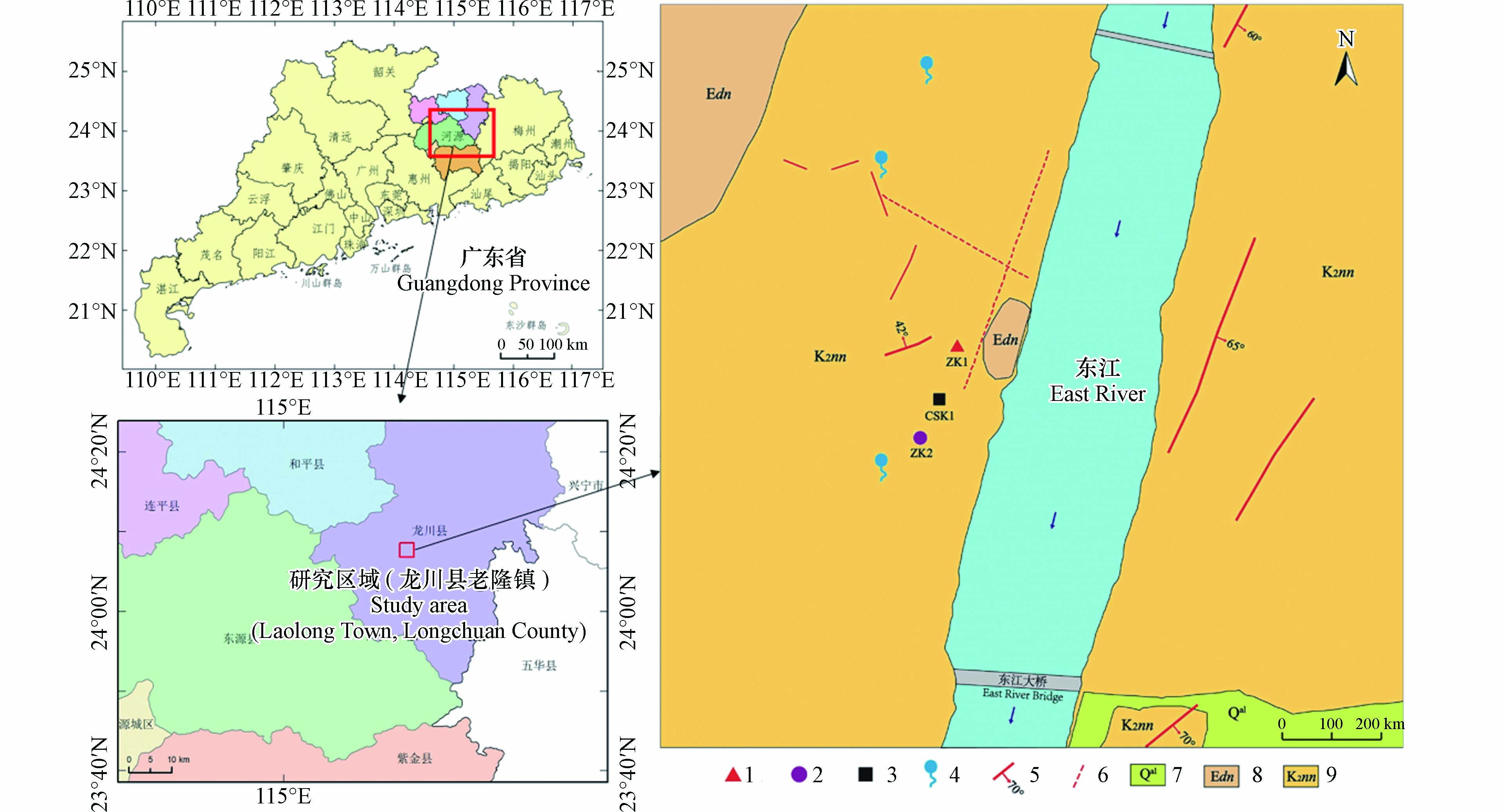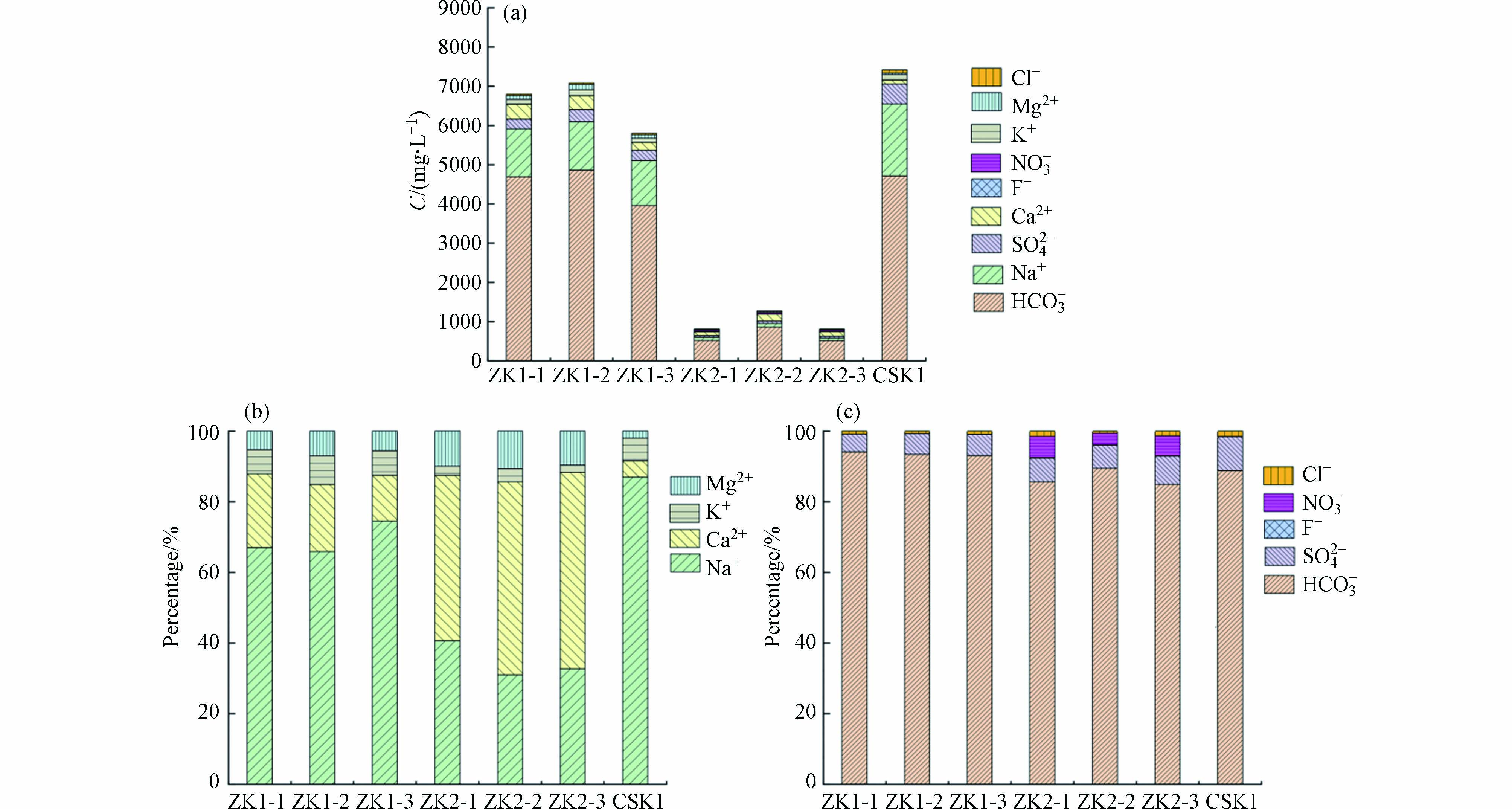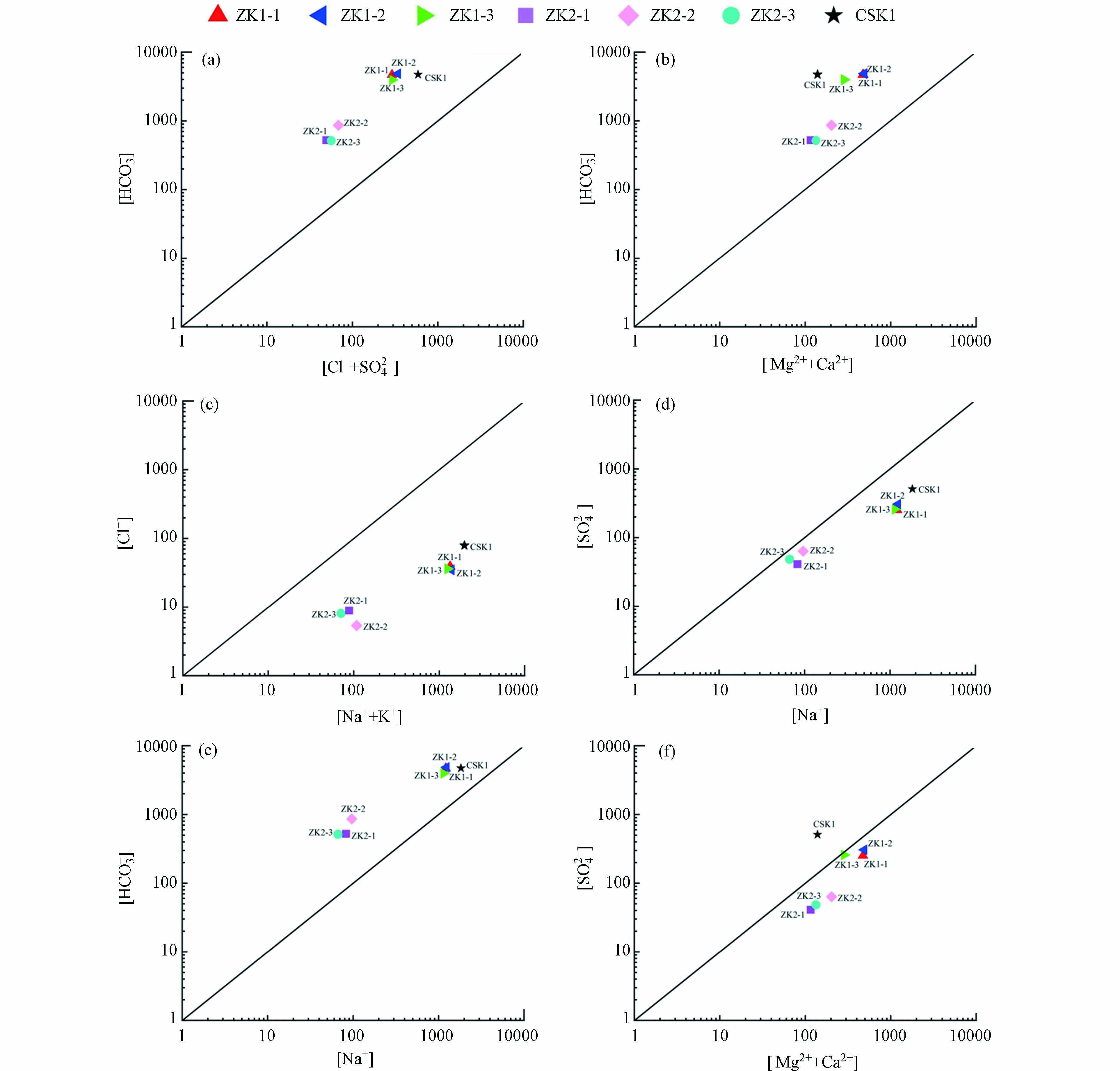-
我国具有非常丰富的碳酸泉水资源,不仅有低温的,也有对科学研究具有重要意义的高温碳酸泉水[1]。碳酸泉具有非常重要的研究价值,不仅在饮用、洗浴等方面具有特殊的医疗保健价值,同时碳酸泉出露带分布与地震活动性关系密不可分,可为地震方面的研究提供参考[2]。碳酸泉含有大量游离CO2,导致水的密度降低、流动性增强,地下热流流动加剧。CO2在上升过程中把深部热量带到地表,会影响当地的地热分布。刘尚任[3]在前人研究数据基础上总结出广东碳酸泉水中游离CO2由岩石热变质作用产生,其出露点地下存在能够汇集和储存碳酸泉水的储集构造,会降低泉水温度。张卫民等[4]利用同位素分析方法,探讨了赣南地区碳酸温泉水、气同位素组成及成因,得出当地碳酸温泉水源于大气降水补给,气源于深部的结论。李静荣等[5]利用地质分析、水化学分析、同位素分析结合的方法,探讨了河源断裂带周边出露碳酸泉的形成机制,分析出碳酸泉水中游离CO2为深部围岩在高温高压作用下热变质所释放,龙川、黎咀盆地盖层因被断裂带切割而使贮集的CO2沿河源深大断裂上升,途中与地下水混合。当前国内外对于碳酸泉的研究较少,且多停留在其医疗价值及与地震之间的联系[6-7],对碳酸泉的形成机理也只做总结性分析,缺少典型数据模型支撑。
广东处于亚欧板块东南边缘,长期受到印度洋板块、太平洋板块和亚欧板块的相对俯冲影响,省内深大断裂发育良好。据研究表明,河源深大断裂带附近有多处碳酸泉分布,其中一处位于龙川县老隆镇泰华城。广东省地球物理探矿大队于2011年在此碳酸泉出露区域开展以深部热储埋藏及深孔碳酸地热水为主的地质与物探基础调查工作,共布设8处钻探。其中代表性的3500.00 m钻探(CSK1)旨在确定井孔温度场与盖层岩性及物性的关系,揭示在水循环条件下热流传输的机理和找出主导控制因素条件。本研究将从深孔碳酸地热水的水化学特征出发,逐步深入阐述其热储和循环特征,为今后碳酸泉形成机理的研究提供科学依据,促进全面认识碳酸泉形成过程,这对未来水文循环、深部流体、地震先兆的研究均有参考意义。
-
龙川县,位于广东省东北部的东江和韩江上游,东连梅州市、汕头市,西靠韶关市,北接江西省,南近粤港澳大湾区。地处亚热带季风气候,气候温和,雨水丰沛,平均温度21.1 ℃,全县水域面积0.7452万公顷,拥有东江、韩江两大水系,年径流量23.33亿m3。地形及地貌相对简单,总体呈中部低,南北高,属于山地丘陵地区[8],地势从东北向西南倾斜。地层从古到今主要包括新元古界,古生界泥盆系、石炭系、二叠系,中生界三叠系、侏罗系、白垩系,新生界古近系和第四系。境内岩浆岩广泛分布,主要为中生代酸性侵入岩,以花岗岩为主体,伴随有中酸性的斑岩。侵入时代从古至今包括中生代三叠纪、侏罗纪、白垩纪。由于经历多次地质构造运动,龙川地区大地褶皱和断裂发育。褶皱构造分布方向主要为北东方向、北北东方向;断裂构造主要为北东方向,北北东方向,且规模较大[9]。
研究区位于河源断裂带附近,岩石地层主要为上白垩统南雄群,分为两个亚群,上部(第一亚群)岩性主要为灰红色流纹岩、石英斑岩及含砾砂岩,下部(第二亚群)岩性为砾岩夹粉砂岩和页岩。地下水的类型主要为红层裂隙水,水量相对贫乏,地下径流模数小于6 L·(s·km2)−1,泉水常见流量小于0.1 L·s−1.
本研究以400.61 m钻孔(ZK1)、180.68 m钻孔(ZK2)、3500.00 m钻孔(CSK1)为例开展。ZK1钻孔涌水量为346.00 m3·d−1,进水部位为348.86—400.61 m的天然井壁,围岩主要为微风化砂砾岩,在351.26—351.36 m深可见方解石洞,此处有喷水喷气现象;ZK2钻孔涌水量为172.00 m3·d−1,进水部位为94.60—110.30 m的花管透水段,围岩主要为微风化砂砾岩,在94.63—95.25 m及108.54—110.36 m深可见蜂窝状岩蚀溶洞;CSK1钻孔涌水量为360.00 m3·d−1,进水部位为3400.00—3500.00 m的花管透水段,围岩主要为微风化花岗岩,成分以石英为主,长石次之。钻孔的具体位置如图1。
-
本研究于2011年8月至2018年8月在研究区共开展了4批次取样,获取碳酸地热水样7组。
现场利用钻孔中CO2的压力,首先采用气举法让钻孔中气液喷出,然后关闭空压机,其后钻孔能自发持续喷出气液。待其稳定后使用水银温度计测量喷出液体的温度(T),精度为0.1 ℃。使用德国 WTW Multi 3400i 多参数水质分析测量仪测量pH值、氧化还原电位(ORP)、电导率(EC)和溶解氧(DO),其精度为0.03 pH、1 mV、1 μS·cm−1、0.1 mg·L−1。水质分析测量仪探头在测量前进行校准。依据《FHZDZDXS0023地下水 碳酸根重碳酸根和氢氧根的测定 酸标准溶液滴定法》现场测量水样的HCO3−,依据《FHZDZDXS0063地下水 游离二氧化碳的测定 滴定法》现场测量水样的CO2。
水样用于元素及离子测量分析时,采用50 mL容量的取样瓶,取样时用带0.45 μm孔径的醋酸纤维脂膜过滤水样,以此去除水中的悬浮物。取样瓶需用过滤后的水样润洗3次,再用过滤后的水样装满,期间严格禁止空气进入及残留。样品立即送至实验室4 ℃冷藏,取样结束后应及时处理样品,水化学指标在水样采集1个月内完成分析测试。其中主要离子、痕量元素的分析均在国土资源部广州矿产资源监督检测中心内完成,执行标准为《DZ/T 0064-1993 地下水质检测方法》、《GB/T 8538-2008饮用天然矿泉水检测方法》、《GB 8538-2016 食品安全国家标准 饮用天然矿泉水检测方法》,检测仪器有PHS-3C型酸度计,精度为0.01 pH和1 mV;UV-1700型紫外可见光光度计,精度为0.3 nm;XGY-1011A型原子荧光光度计,检出限小于0.2 μg·L−1;ELAN DRC-e型电感耦合等离子体质谱仪,分辨率为0.3—3 amu、Optima 2000DV型电感耦合等离子体发射光谱仪等,检出限小于0.01 mg·L−1。
-
水样的物理化学特征参数如表1所示。对各水样数据做阴阳离子平衡检验,相对误差E(ZK1)为0.40%—1.16%;E(ZK2)为0.09%—1.32%;E(CSK1)为0.48%,水样数据可靠。从表1可以看出,研究区的碳酸地热水pH值变化范围为6.74—7.34,以中性水为主。ZK1水样溶解性总固体(TDS)介于5847.22—7121.10 mg·L−1,ZK2水样TDS介于839.85—1309.24 mg·L−1,CSK1水样TDS为7480.75 mg·L−1,钻孔水样中TDS及电导率随深度的增加而增大。ZK1钻孔水温变化范围为25.8—27.0 ℃;ZK2钻孔水温变化范围为25.3—25.8 ℃;CSK1钻孔水温为48 ℃。水温高于普通非碳酸泉,表明碳酸地热水来源于深层地下热水。
由图2可知,碳酸地热水的主要阳离子有Na+和Ca2+,占阳离子总量的90%左右;阴离子主要有HCO3−,占阴离子总量的85%左右。3处钻孔不同时间获取的水样中游离CO2最高分别为1000.82 mg·L−1 (ZK1)、502.45 mg·L−1 (ZK2)和396.97 mg·L−1 (CSK1)。我国饮用天然矿泉水标准规定,碳酸矿泉水中游离CO2的含量应大于等于250 mg·L−1,3处钻孔取的水都可以称为碳酸矿泉水,其中ZK1钻孔两次水样中游离CO2为1000.82 mg·L−1和806.78 mg·L−1,远超我国的碳酸矿泉水标准,具有重要研究意义。
通过绘制Piper三线图,分析研究区水体的水化学特征,按照舒卡列夫分类法对采集的水样进行分类。由图3可知,ZK1钻孔、CSK1钻孔水样为Na-HCO3型水,ZK2钻孔水样为Na-Ca-HCO3型水。水样在阳离子三角图中主要分布在Na+K高值区,碳酸地热水水化学性质以碱金属和弱酸为主。CSK1钻孔水样中Na+远超于Ca2+,是由于研究区域深部有大面积花岗岩地层,碳酸地热水进入这种地层中时,其大量游离CO2促进了水的溶滤作用,在强烈的离子交换作用下,易形成重碳酸钠型碳酸地热水[5]。
-
通常运用Na-K-Mg三角图解判断并分析研究区域的水-岩平衡状态[10]。图4中所有水样均处于未成熟水区域内,即未达到水-岩平衡状态。其中ZK2水样全部位于三角图右下角顶点处,说明ZK2水样处于水-岩作用初级阶段。CSK1水样离半平衡线较近,说明3500 m深处因高温影响,水-岩作用有所提高。相较于其他两个钻孔,CSK1水样能更好的反映深部碳酸地热水储水特征。龙川地区碳酸地热水与广东沿海地区地下热水相比,粤东粤西地下热水成熟度更高,其深部水-岩相互作用更强或者可能是与更成熟的地下水混合[10-11]。
由于矿物的溶解作用,深部围岩中的某些成分会溶解到地下水中,导致不同区域地下水的水化学成分差别较大,其中发生的水文地球化学作用往往受水-岩作用的控制。由于深部水-岩作用往往比较复杂,通过传统单一的阴、阳离子比值来分析深部水文地球化学作用存在局限性,本研究使用了美国地质调查局研究开发的PHREEQC软件,用于研究区域不同矿物的饱和指数计算,进一步查明水-岩平衡状态[12-14]。
利用矿物饱和指数(SI)可以判断并分析地下水与矿物之间的反应状态。矿物饱和指数的计算公式为:
式(1)中,SI代表矿物饱和指数;IAP代表离子活度;K代表平衡常数。
当SI<0时,表明该矿物在地下水中并没有达到饱和状态,当地下水中存在该矿物时,矿物会被地下水所溶解;当SI>0时,表明该矿物在地下水中达到过饱和状态,从而认为该矿物为非反应性矿物;当SI的范围在-0.5至0.5之间,表明矿物趋于平衡状态。
利用PHREEQC计算了钻孔水样中硬石膏、文石、方解石、白云石、萤石、岩盐、石膏、天青石、SiO2、玉髓的饱和指数。从表2可以看出,ZK1钻孔水样中硬石膏、岩盐、石膏、天青石、SiO2的SI<−0.5,矿物处于不饱和状态,文石、方解石、白云石SI>0.5,矿物处于过饱和状态,萤石、玉髓SI处于−0.5至0.5之间,矿物趋于平衡状态;ZK2钻孔水样中硬石膏、萤石、岩盐、石膏、天青石、SiO2的SI<−0.5,矿物处于不饱和状态,文石、方解石、白云石、玉髓SI处于−0.5至0.5之间,矿物趋于平衡状态;CSK1钻孔硬石膏、岩盐、石膏、天青石、SiO2处于不饱和状态,文石、方解石、白云石处于过饱和状态,萤石和玉髓则趋于平衡状态。就这十种矿物饱和指数而言,ZK1水样与CSK1水样较为相似。研究区水样中硬石膏和石膏都处于不饱和的状态,表明地下水对硫酸盐矿物的溶解是一个正在发生并持续的过程。文石、方解石、白云石处于过饱和状态或趋于平衡,表明碳酸盐矿物和硅酸盐矿物出现明显的沉淀现象。
-
研究区碳酸地热水从深部向上运移的过程中与围岩发生水-岩相互作用,水中的高含量离子主要来自于深部岩石矿物的溶解。
由图5(a)可以看出,数据点均在[Cl−+SO42-]与[HCO3−] 1:1等量线上方且偏离等量线较远,表明研究区水样碳酸盐矿物来源或CO2气体来源远大于蒸发岩来源。
由图5(b)可以看出,数据点均在[Mg2++Ca2+]与[HCO3−] 1:1等量线上方,表明碳酸盐矿物风化作用不能完全解释Mg2++Ca2+的组成,HCO3−除了来源于碳酸盐矿物溶解作用,还有存在其他来源,根据图5(a)结论可知CO2气体是研究区地下水中HCO3−的重要来源。
图5(c)显示了[Na++K+]与[Cl−]的关系,当蒸发岩的溶滤作用是水化学组成起的主要作用时,[Na++K+]与[Cl−]的比值应为1:1[15]。各数据点均偏离等量线且处于等量线的下方,表明研究区既发生蒸发岩的溶滤作用,硅铝酸盐矿物的溶解也在同时进行[16]。与河源市非碳酸泉对比[5],非碳酸泉与ZK2水样中[Na++K+]与[Cl−]较为相似,而ZK1和CSK1水样中[Na++K+]与[Cl−]较大,表明研究区深部(大于300 m)蒸发岩和硅铝酸盐的溶滤作用强,碳酸地热水中游离CO2促进了硅铝酸盐的溶滤。
由图5(d)和图5(e)可以看出,数据点均处于[Na+]与[SO42-] 1:1等量线的下方,同时处于[Na+]与[HCO3−] 1:1等量线上方,说明水样中的Na+除蒸发岩来源和硅铝酸盐矿物来源,同时可能来源于硫酸盐矿物的溶解[17]。
由图5(f)可以看出,ZK1数据点接近[Ca2++Mg2+]与[SO42-] 1:1等量线,说明硫酸盐矿物的溶解产生大部分的Ca2+和Mg2+;而ZK2和CSK1数据点偏离等量线,说明硫酸盐矿物的溶解只产生部分Ca2+和Mg2+,其主要来源可能是含钙含镁的硅铝酸盐和碳酸盐的溶滤[5]。
γNa+/γCl−值反映阳离子交换水平,称之为地下水的成因系数[18]。由图6(a)可知,ZK2水样的γNa+/γCl−比值均小于1,而且Na+和Cl−含量也相对较低,反映研究区地下100 m处未发生强烈的溶滤作用,而ZK1水样的γNa+/γCl−比值均大于1且CSK1水样的γNa+/γCl−比值远超于1,说明深部发生较为强烈的水-岩相互作用,阳离子交换作用或蒸发岩的溶滤作用随深度的增加而增强。
γCa2+/γMg2+值与地下水的变质程度及封存时间为正相关[19]。由图6(b)可知,所有水样γCa2+/γMg2+均小于3.5,说明研究区碳酸地热水的封存时间较短,变质程度较低,运移环境较为开放。
γNa+/γ(Na++Ca2++Mg2+)与γCl−的比值图可反映Na+/Ca2+及Na+/Mg2+之间的交换作用,比值越大,交换作用越强[20]。由图6(c)可知,CSK1的比值较高,反映交换作用较强,而ZK2的比值较低,反映交换作用较弱。这表明研究区地下水Na+/Ca2+及Na+/Mg2+之间的交换作用随深度的增加而增强。
γ(Ca2++Mg2+)/γ(HCO3−+SO42-)比值可判断HCO3−,Ca2+和Mg2+来源[21]。由图6(d)可知,所有水样γ(Ca2++Mg2+)均小于γ(HCO3−+SO42-),且随深度的增加,γ(Ca2++Mg2+)/γ(HCO3−+SO42-)比值减小,CSK1水样比值小于0.1,说明硫酸盐矿物或碳酸盐矿物对深层地下水化学组分影响较大。
结合以上分析,可以总结出研究区不同深度水-岩作用对水化学形成影响的规律。龙川地区碳酸地热水中高含量离子主要来自于深部碳酸盐矿物的溶解。随深度的增加,地下温度升高,阳离子交换作用增强,其中高浓度游离CO2强化了水的溶滤作用,水-岩作用相对提高。100 m处地下水主要进行碳酸盐矿物的溶解,推测水中离子主要来源于方解石晶脉;400 m深处硫酸盐矿物溶解作用强烈,给地下水带来大量的Ca2+、Mg2+。3500 m深处水-岩作用较为强烈,其中高浓度HCO3−来源于游离CO2和碳酸盐矿物,Na+、K+来源于蒸发岩和硅铝酸盐矿物,Ca2+、Mg2+来源于硫酸盐矿物及含钙含镁的硅铝酸盐矿物。由于研究区处于内陆地区,与广东沿海地区的地下水的离子比值特征不同。粤东裂隙型地下水高含量离子主要是来自硅酸盐和碳酸盐矿物溶解[11],粤西地下水则主要是硅酸盐矿物的溶解[21]。
-
由图4可知,碳酸地热水样均未达到水-岩平衡状态,因此估算深部热储温度时不适合采用阳离子温标。从表2可知,石英和玉髓矿物趋于平衡状态,可采用石英温标和玉髓温标来估算深部热储,计算公式如下[22]:
式(2)为石英-无蒸汽损失地热温标;式(3)为玉髓地热温标;T为热储温度,单位℃;S为SiO2浓度,单位mg·L−1。
作为地热温标的化学组分有很多,同一热水系统用不同的地热温标得到的结果可能会有很大的差异。利用多矿物平衡图解法可以弥补不同温标方法结果的差异[22]。根据水样的水化学资料,利用PHREEQC计算了地下多种矿物在温度范围(25—175 ℃)的平衡状态,结果见图7。
由于铝在深部的含量很低且难以准确测定,本文采用Reed和Pang提出的固定铝的FixAl法[23],ZK1钻孔水样固定铝含量为0.05 mg·L−1,ZK2钻孔水样固定铝含量为0.04 mg·L−1,CSK1钻孔水样固定铝含量为0.07 mg·L−1。从图7可以看出固定铝矿物平衡图显示出较为良好的收敛性,可以读取出各钻孔的深部热储温度。
热储温度结果如表3所示。由石英-无蒸汽损失地热温标估算热储温度,研究区深部热储温度介于76.90—115.44 ℃;由玉髓地热温标估算热储温度,研究区深部热储温度介于48.29—86.89 ℃;由多矿物平衡法估算热储温度,研究区深部热储温度介于59.66—102.35 ℃。在低于180 ℃的温度下,二氧化硅的溶解度通常由玉髓控制[24],相较于石英温标,玉髓温标得出的热储温度与由多矿物平衡法得出的热储温度更接近,且玉髓比石英更接近平衡状态,证明了玉髓温标比石英温标更适合估算研究区地下热储的地热温标,而石英温标指示的则是热储可能的最高温度[25]。CSK1钻孔在3340 m深处附近实测温度为95.3 ℃,与多矿物平衡法估算结果接近。因此本研究采用多矿物平衡法指示的温度作为研究区深部热储温度。
通过对研究区地下热水热储温度的计算值可以用来估算热水的循环深度。上述多矿物平衡法适合估算研究区热储温度,因此使用其估算的深部热储温度计算热水循环深度,计算公式为:
式(4)中,H为碳酸地热水的循环深度,单位为m;T为热储温度,单位为℃;T0为龙川县平均气温,取21.1 ℃;h为常温层深度,取15.0 m;g为地温梯度,单位为℃·(100 m)−1。
研究区地温由CSK1水文地质钻探测得,如图8所示,可计算出当地地温梯度g为2.3 ℃·(100 m)−1。由式(4)可计算出研究区地下热水循环深度介于1691.5—3547.6 m。广东沿海地区地温梯度为2.49—4.5 ℃·(100 m)−1,热水循环深度介于566.3—3148.6 m[11]。两者比较可以推断出,地温梯度越高,地下水接受深部热储热量加热到一定温度所需要的循环深度越小。
-
本文研究了广东省龙川县深孔碳酸地热水的水化学特征,通过研究水-岩平衡状态及相互作用、估算热储温度及热水循环深度,得出主要结论如下:
(1)研究区深孔碳酸地热水来源于深部地下热水,属中性水,受地下储集构造影响导致温度较低,溶解性总固体含量随深度增加而增大,水化学类型皆为重碳酸型,可分为浅部Na-Ca-HCO3型水和深部Na-HCO3型水。
(2)Na-K-Mg三角图解和PHREEQC计算的矿物饱和指数均表明深孔碳酸地热水处于未饱和状态,CSK1水样显示3500 m深部对比于浅部水-岩作用有所提高。
(3)碳酸地热水中高含量离子主要来自于深部碳酸盐矿物的溶解。大量游离CO2运移过程中强化了水的溶滤作用,离子交换作用强烈,影响了水化学组分特征的形成,同时CO2是水中高含量HCO3−主要来源。
(4)由钻孔实测温度表明多矿物平衡法最适合估算研究区热储。多矿物平衡法估算研究区热储温度为59.66—102.35 ℃,热水循环深度介于1691.5—3547.6 m。
综合分析研究区域地热地质、碳酸地热水的水化学特征,并结合前人的工作基础[5,27-28],得出广东省龙川县深孔碳酸地热水的形成过程可能为:河源深大断裂高地势区域接受大气降水补给,地下水在重力作用下向深部移动。接受深部热源加热后,地下水温度升高,密度降低,浮力增大,并沿断裂带上升。深部碳酸盐岩地层在高温高压下热变质并释放大量CO2气体,CO2与地热水混合后沿断裂带上升,途中与围岩进行强烈的水-岩作用,产生大量HCO3−,形成特征鲜明的碳酸地热水。
广东省龙川县深孔碳酸地热水的水化学特征
Hydrochemical characteristics of carbonated geothermal water from deep borehole in Longchuan County, Guangdong Province
-
摘要: 碳酸泉以富含游离CO2为特征,主要分布在深大断裂带和地震活动带上。通过针对广东省龙川县3个不同深度的钻孔数据对碳酸地热水的水文地球化学特征进行研究,揭示其水化学组分主要为碳酸盐矿物溶解控制,游离CO2运移过程中强化了水的溶滤作用。Na-K-Mg三角图解和PHREEQC计算表明水-岩作用处于不平衡状态,通过石英温标、玉髓温标及多矿物水-岩平衡估算了地热水的热储温度为60—102 ℃,循环深度为1692—3548 m。该水化学特征成果可以进一步讨论碳酸泉的形成机理,反映气体在深部地热流和温度剖面中的作用,为研究深部流体对地震的同震响应及地热资源开发提供依据。Abstract: Carbonated springs are characterized by the enrichment of free CO2, which are mainly distributed in deep fault zones and seismic active belts. Based on the data from three boreholes at different depths in Longchuan County, Guangdong Province, the hydrogeochemical characteristics of carbonated geothermal waters have been studied in our work. The results reveal that the chemical compositions of the water samples are mainly controlled by the dissolution of carbonate minerals, and the migration process of free CO2 strengthens the leaching effect of water. The Na-K-Mg triangle diagram and PHREEQC calculations show that the water-rock interaction is in an unbalanced state. According to the quartz, chalcedony geothermometer results as well as multimineral water-rock balance calculations, the reservoir temperatures and the circulation depths in the study area are estimated to be 60—102 ℃ and 1692—3548 m, respectively. The study on the hydrochemical characteristics of geothermal waters can further improve our understanding of the formation mechanism of carbonated springs, which not only provides new insight into the role of gas in deep geothermal flow and temperature profile, but also makes contributions to the study of the coseismic response of deep fluids to earthquakes and the future exploitation of geothermal resources.
-
Key words:
- carbonated spring /
- hydrochemistry /
- geothermal water /
- fault zone /
- water-rock interaction
-

-
表 1 水样的物理化学特征参数
Table 1. Physicochemical properties of the water samples
编号
No.取样日期
DatepH T/℃ TDS/
(mg·L−1)K+/
(mg·L−1)Na+/
(mg·L−1)Ca2+/
(mg·L−1)Mg2+/
(mg·L−1)HCO3-/
(mg·L−1)Cl-/
(mg·L−1)SO42-/
(mg·L−1)F-/
(mg·L−1)NO3−/
(mg·L−1)Si/
(mg·L−1)CO2/
(mg·L−1)ZK1-1 2011.11.29 7.10 25.80 6840.52 123.61 1214.40 378.53 95.95 4694.51 39.00 252.53 2.49 0.31 19.32 806.78 ZK1-2 2011.12.29 7.07 26.30 7121.10 151.12 1237.00 356.23 132.64 4858.34 34.91 306.39 2.68 0.59 20.47 1000.82 ZK1-3 2018.08.27 7.07 27.00 5847.22 107.40 1150.00 199.48 86.02 3959.53 36.12 258.15 2.52 0.00 22.39 545.82 ZK2-1 2011.11.29 6.86 25.30 839.85 5.27 83.13 95.83 20.35 520.01 8.86 40.89 0.38 37.06 13.17 105.19 ZK2-2 2011.12.29 6.74 25.80 1309.24 11.56 96.30 170.02 33.16 861.51 5.37 63.43 0.41 31.93 16.73 502.45 ZK2-3 2012.02.05 6.99 25.70 840.34 4.12 66.71 113.35 19.65 515.96 8.06 48.37 0.22 35.08 13.54 106.21 CSK1 2018.08.27 7.34 48.00 7480.75 135.00 1830.00 97.51 41.67 4716.48 79.05 509.20 5.44 0.00 30.93 396.97 表 2 研究区水样部分矿物饱和指数值(SI)a
Table 2. Partial mineral saturation index values of water samples in the study areaa
编号
No.硬石膏
Anhydrite文石
Aragonite方解石
Calcite白云石
Dolomite萤石
Fluorite岩盐
Halite石膏
Gypsum天青石
CelestiteSiO2 玉髓
ChalcedonyZK1-1 −1.46 1.35 1.50 2.77 −0.10 −6.03 −1.17 −1.51 −0.77 0.06 ZK1-2 −1.42 1.31 1.45 2.85 −0.10 −6.08 −1.13 −1.33 −0.75 0.08 ZK1-3 −1.64 1.03 1.17 2.36 −0.32 −6.08 −1.36 −1.65 −0.72 0.11 ZK2-1 −2.26 −0.05 0.10 −0.13 −1.82 −7.72 −1.96 −1.68 −0.95 −0.11 ZK2-2 −1.94 0.24 0.38 0.42 −1.63 −7.90 −1.65 −1.30 −0.85 −0.01 ZK2-3 −2.12 0.15 0.30 0.19 −2.22 −7.86 −1.83 −1.48 −0.94 −0.10 CSK1 −1.55 1.24 1.37 2.89 −0.28 −5.58 −1.49 −1.39 −0.74 0.03 注:a.水化学数据见表1. Note: a. Hydrochemical data are shown in Table 1. 表 3 采样点热储温度估算
Table 3. Estimation of Heat Storage temperature at sampling points
编号
No.水样温度/℃
Water samples
temperature地温计法-石英-无蒸汽损失/℃
Geothermometer method-Quartz-no
steam loss地温计法-玉髓/℃
Geothermometer
method-Chalcedony矿物平衡法/℃
Multiple mineral
equilibrium methodZK1-1 25.80 93.22 64.55 67.38 ZK1-2 26.30 95.80 67.13 66.55 ZK1-3 27.00 99.89 71.23 69.00 ZK2-1 25.30 76.90 48.29 70.91 ZK2-2 25.80 86.91 58.25 66.98 ZK2-3 25.70 78.04 49.42 59.66 CSK1 48.00 115.44 86.89 102.35 -
[1] 石慧馨. 中国碳酸水出露带分布特征简介 [J]. 地震地质, 1979, 1(2): 86-93. SHI H X. A note on carbon-dioxide discharging zones and their seismicities in China [J]. Seismology and Geology, 1979, 1(2): 86-93(in Chinese).
[2] 李富光. 碳酸水与龙南地震 [J]. 华南地震, 1983, 3(1): 30-33. doi: 10.13512/j.hndz.1983.01.006 LI F G. Carbonated water and Longnan earthquake [J]. South China Journal of Seismology, 1983, 3(1): 30-33(in Chinese). doi: 10.13512/j.hndz.1983.01.006
[3] 刘尚仁. 广东省碳酸水的特征和成因探讨[J]. 广东地质, 1997(4): 63-69. LIU S R. A discussion on the characteristic and origin of carbonated water. Guangdong Geology, 1997(4): 63-69(in Chinese).
[4] 孙占学, 刘金辉, 高柏, 等. 赣南横迳地区碳酸温泉的同位素水文地球化学研究[C]//. 中国地球物理学会第十九届年会论文集. 中国地球物理学会, 2003: 696-697. SUN Z X, LIU J H, GAO B, et al. Study on isotope hydrogeochemistry of carbonate hot springs in Hengjing area, southern Jiangxi. Chinese Geophysical Society. Proceedings ot the 19th Annual Meeting of Chinese Geophysical Society [C]. Chinese Geophysical Society, 2003: 696-697(in Chinese).
[5] 李静荣, 王中正, 王亚, 等. 广东省河源断裂带碳酸泉水化学特征及形成机制 [J]. 中山大学学报(自然科学版), 2018, 57(5): 19-28. LI J R, WANG Z Z, WANG Y, et al. The chemical characteristics and formation mechanisms of carbonate springs along Heyuan fault zone, Guangdong Province [J]. Acta Scientiarum Naturalium Universitatis Sunyatseni, 2018, 57(5): 19-28(in Chinese).
[6] 龙绍都. 碳酸泉形成条件及其利用价值 [J]. 水文地质工程地质, 1988, 15(4): 56-58,54. LONG S D. Formation conditions and utilization value of carbonated springs [J]. Hydrogeology and Engineering Geology, 1988, 15(4): 56-58,54(in Chinese).
[7] 上官志冠, 高松升. 滇西地区二氧化碳的释放与地震 [J]. 地震学报, 1990, 12(2): 186-193,225. SHANGGUAN Z G, GAO S S. The CO2 discharges and earthquakes in western Yunnan [J]. Acta Seismologica Sinica, 1990, 12(2): 186-193,225(in Chinese).
[8] 陈律. 遥感技术广东龙川县地质灾害调查的应用 [J]. 甘肃科技, 2020, 36(20): 65-67. doi: 10.3969/j.issn.1000-0952.2020.20.022 CHEN L. Application of remote sensing technology in geological disaster investigation in Longchuan County of Guangdong Province [J]. Gansu Science and Technology, 2020, 36(20): 65-67(in Chinese). doi: 10.3969/j.issn.1000-0952.2020.20.022
[9] 祝小辉. 广东省龙川县地质灾害特征及影响因素分析 [J]. 西部资源, 2021(2): 106-108. ZHU X H. Analysis on characteristics and influencing factors of geological disasters in Longchuan county, Guangdong province [J]. Western Resources, 2021(2): 106-108(in Chinese).
[10] 汪啸. 广东沿海典型深大断裂带地热水系统形成条件及水文地球化学特征[D]. 武汉: 中国地质大学, 2018. WANG X. Formation conditions and hydrogeochemical characteristicsof the geothermal water in typical coastal geothermal field with deep faults, Guangdong Province[D]. Wuhan: China University of Geosciences, 2018(in Chinese).
[11] 袁建飞. 广东沿海地热系统水文地球化学研究[D]. 武汉: 中国地质大学, 2013. YUAN J F. Hydrogeochemistry of the geothermal systems in coastal areas of Guangdong Province, South China[D]. Wuhan: China University of Geosciences, 2013(in Chinese).
[12] REED M, SPYCHER N. Calculation of pH and mineral equilibria in hydrothermal waters with application to geothermometry and studies of boiling and dilution [J]. Geochimica et Cosmochimica Acta, 1984, 48(7): 1479-1492. doi: 10.1016/0016-7037(84)90404-6 [13] 许万才. 饱和指数法在地下热水化学研究中的应用 [J]. 长安大学学报(地球科学版), 1992, 14(3): 66-70. XU W C. Application of the saturation index method to the study of geothermal geochemistry [J]. Journal of Chang'an University Earth Science Edition, 1992, 14(3): 66-70(in Chinese).
[14] 刘峰. 地球化学反应模型用于水—岩相互作用的研究: 以模拟软件Phreeqc应用为例[D]. 北京: 中国地质大学(北京), 2010. LIU F. Study on water-rock interaction using geochemical reaction modeling—taking simulation software phreeqc for example[D]. Beijing: China University of Geosciences, 2010(in Chinese).
[15] GIBBS R J. Mechanisms controlling world water chemistry [J]. Science, 1970, 170(3962): 1088-1090. doi: 10.1126/science.170.3962.1088 [16] 卓勇, 吴勇, 孙为奕, 等. 贵州威宁草海地区地下水化学特征与控制因素研究 [J]. 科学技术与工程, 2016, 16(8): 59-65. doi: 10.3969/j.issn.1671-1815.2016.08.009 ZHUO Y, WU Y, SUN W Y, et al. Hydrochemistry characteristic and the control factor of groundwater of Caohai area in Weining County, Guizhou Province [J]. Science Technology and Engineering, 2016, 16(8): 59-65(in Chinese). doi: 10.3969/j.issn.1671-1815.2016.08.009
[17] 朱秉启, 杨小平. 塔克拉玛干沙漠天然水体的化学特征及其成因 [J]. 科学通报, 2007, 52(13): 1561-1566. doi: 10.3321/j.issn:0023-074X.2007.13.013 ZHU B Q, YANG X P. Chemical characteristics and origin of natural waters in Taklimakan Desert [J]. Chinese Science Bulletin, 2007, 52(13): 1561-1566(in Chinese). doi: 10.3321/j.issn:0023-074X.2007.13.013
[18] 张保建. 鲁西北地区地下热水的水文地球化学特征及形成条件研究[D]. 北京: 中国地质大学(北京), 2011. ZHANG B J. Hydrogeochemical characteristics and formation conditions of the geothermal water in northwestern Shandong Province[D]. Beijing: China University of Geosciences, 2011(in Chinese).
[19] 姚永仲. 弥渡温泉地质特征及成因模式分析[D]. 昆明: 昆明理工大学, 2010. YAO Y Z. Analysis of geological characteristics and genetic model of Midu Hot Spring[D]. Kunming: Kunming University of Science and Technology, 2010(in Chinese).
[20] 赵江涛, 周金龙, 梁川, 等. 新疆焉耆盆地平原区地下水演化的主要水文地球化学过程分析 [J]. 环境化学, 2017, 36(6): 1397-1406. doi: 10.7524/j.issn.0254-6108.2017.06.2016091807 ZHAO J T, ZHOU J L, LIANG C, et al. Hydrogeochemical process of evolution of groundwater in plain area of Yanqi, Xinjiang [J]. Environmental Chemistry, 2017, 36(6): 1397-1406(in Chinese). doi: 10.7524/j.issn.0254-6108.2017.06.2016091807
[21] 王贝贝, 卢国平, 胡晓农, 等. 粤西深大断裂温热泉水化学分析 [J]. 环境化学, 2019, 38(5): 1150-1160. WANG B B, LU G P, HU X N, et al. Hydrochemical characterization of thermal spring waters in the deep fault region in western Guangdong [J]. Environmental Chemistry, 2019, 38(5): 1150-1160(in Chinese).
[22] 海阔. 运用多种方法估算深部热储温度[D]. 北京: 中国地质大学(北京), 2019. HAI K. Using several methods to estimate the temperatures of deep geothermal reservoirs[D]. Beijing: China University of Geosciences, 2019(in Chinese).
[23] 张展适, 孙占学, 王素娟. 固定铝方法成功恢复汤湖温泉热储平衡温度及其研究意义 [J]. 华东地质学院学报, 2003, 26(4): 306-310. ZHANG Z S, SUN Z X, WANG S J. Successful reconstruction the equilibrium status of Tanghu hot spring by using Fixed-Al methods and it's meaningness [J]. Journal of East China Geological Institute, 2003, 26(4): 306-310(in Chinese).
[24] ZHANG Y Q, ZHOU X, LIU H S, et al. Hydrogeochemistry, geothermometry, and genesis of the hot springs in the Simao Basin in southwestern China [J]. Geofluids, 2019, 2019: 7046320. [25] 刘军强. 应用地热温标估算热储温度: 以嵊州崇仁热水为例 [J]. 西部探矿工程, 2014, 26(5): 129-132. doi: 10.3969/j.issn.1004-5716.2014.05.043 LIU J Q. Estimation of heat storage temperature using geothermal temperature scale: Take Shengzhou Chongren hot water as an example [J]. West-China Exploration Engineering, 2014, 26(5): 129-132(in Chinese). doi: 10.3969/j.issn.1004-5716.2014.05.043
[26] 庞忠和, 罗霁, 程远志, 等. 中国深层地热能开采的地质条件评价 [J]. 地学前缘, 2020, 27(1): 134-151. PANG Z H, LUO J, CHENG Y Z, et al. Evaluation of geological conditions for the development of deep geothermal energy in China [J]. Earth Science Frontiers, 2020, 27(1): 134-151(in Chinese).
[27] Lisa TANNOCK, 王亚, 李景富, 等. 广东河源断裂带地热成因及与构造关系初探 [J]. 地质力学学报, 2019, 25(3): 400-411. doi: 10.12090/j.issn.1006-6616.2019.25.03.037 TANNOCK L, WANG Y, LI J F, et al. A preliminary study on the mechanics and tectonic relationship to the geothermal field of the Heyuan fault zone in Guangdong Province [J]. Journal of Geomechanics, 2019, 25(3): 400-411(in Chinese). doi: 10.12090/j.issn.1006-6616.2019.25.03.037
[28] QIU X L, WANG Y, WANG Z Z, et al. Determining the origin, circulation path and residence time of geothermal groundwater using multiple isotopic techniques in the Heyuan Fault Zone of Southern China [J]. Journal of Hydrology, 2018, 567: 339-350. doi: 10.1016/j.jhydrol.2018.10.010 -




 下载:
下载:








